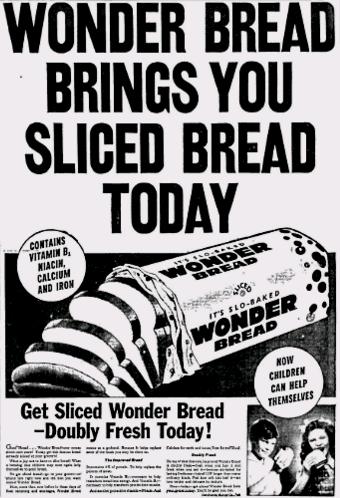This ad for sliced Wonder Bread appeared in the Milwaukee Sentinel, March 9, 1943. It heralded the end of one of the most unusual aspects of wartime economic controls, namely, the ban on sliced bread.
On January 18, 1943, the War Foods Administration handed down its edict that, as a wartime measure, the sale of sliced bread would be banned. Thereafter, only unsliced loaves would be for sale, and the hapless housewife would need to cut it herself. As the Wonder Bread ad above notes, one effect was that children couldn’t get a slice of bread by themselves.
The exact rationale for the ban was never made entirely clear, but the ostensible reason was that it would save on waxed paper, since the unsliced loaf would stay fresh longer by itself, and wouldn’t need to be wrapped as well. But there was no shortage of wax paper, and most bakeries had sufficient stocks on hand.
As might be epxected, this edict didn’t go over well with the general public. Some bakeries simply ignored the ban and condtinued to slice the bread for customers on request. One housewife wrote the following letter to the editor of the New York Times:
I should like to let you know how important sliced bread is to the morale and saneness of a household. My husband and four children are all in a rush during and after breakfast. Without ready-sliced bread I must do the slicing for toast—two pieces for each one—that’s ten. For their lunches I must cut by hand at least twenty slices, for two sandwiches apiece. Afterward I make my own toast. Twenty-two slices of bread to be cut in a hurry!
The ban was quickly lifted, sliced bread went back on sale in March, and as the Wonder Bread ad notes, children could once again get a slice of bread all by themselves.
References
Click Here For Today’s Ripley’s Believe It Or Not Cartoon
![]()

